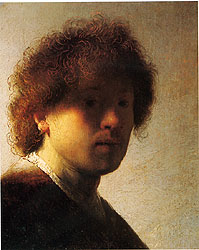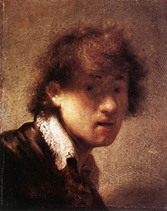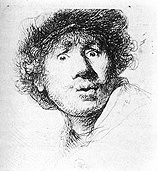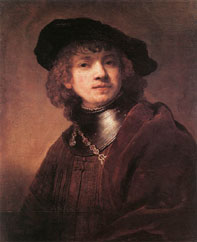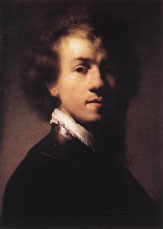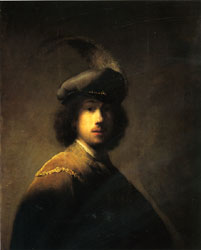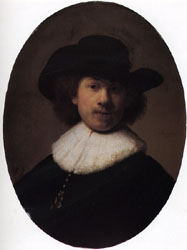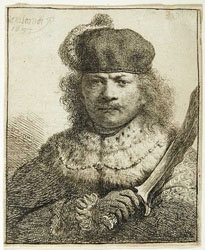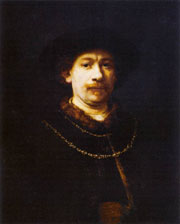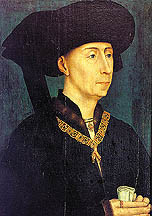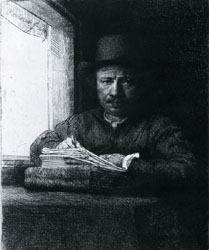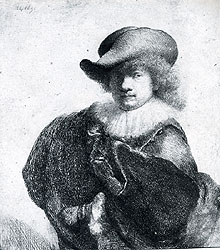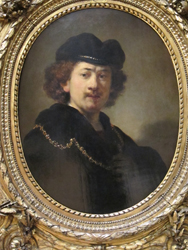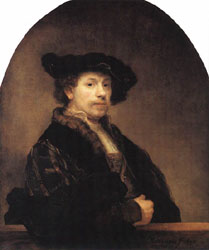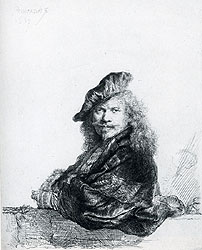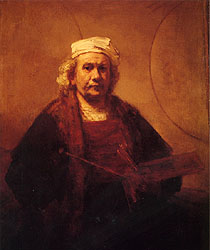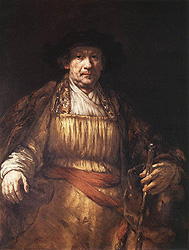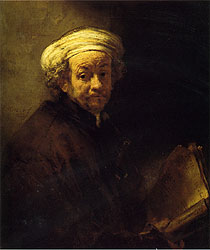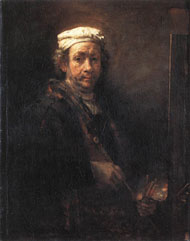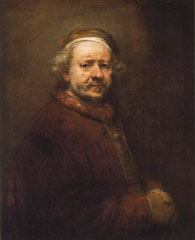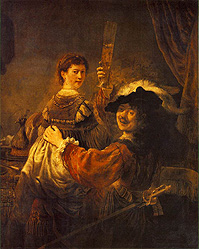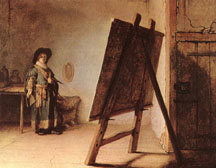Rembrandt, Self-Portrait, 1629. Boston, Isabella Stewart Gardner Museum. Chapman, p. 46:...Rembrandt asserts his sense of importance. His fancy dress consists of a sumptuous silvery-blue beret adorned with a large ostrich plume and jeweled band, a silk scarf, a mustard-yellow mantle, and a chain of ornate links with a heavy medallion, all rendered with careful attention to detail and texture. Evocative handling of light and shadow is one of the painting's most distinctive features: sharp light strikes Rembrandt's hat, his shoulders, and the right side of his face, leaving his eyes and much of his face in darkness.
p.47: Most extraordinary, however, are the chains around his neck. These were often worn in self-portraits, but most, like that in the portrait of Rubens painted for Charles I, were real chains, given to the painter by a noble patron. Rembrandt, however, had not been granted one, nor would he be. His historicized costume and chain, in particular, reflect not his actual circumstances but an appearance that depends heavily on artistic convention. By reinterpreting this self-portrait convention he formulated an ideal of the painter that distinguished him from te typical Dutch artist and removed him from his everyday reality.
Rembrandt, Self-Portrait as an Oriental Potentate, 1634.
In this portrait and the etching Self-Portrait Leaning on a Stone Sill, Rembrandt takes on another guise, that of the Renaissance Gentleman-artist. These works were clearly influenced by two great half-length portraits from the Renaissance that were in Amsterdam collections: Raphael's Portrait of Baldassare Castiglione and Titian's Portrait of a Man (Ariosto). Significantly, Castiglione was the author of the Book of the Courtier first published in 1528. In this courtesy book, Castiglione lays out the intellectual, ethical, and cultural foundations for the formation of the proper courtier. Castiglione articulates the self-fashioning of the ideal gentleman-virtuoso. It is this ideal that Rembrandt emulates in these two portraits.
Both works demonstrate Rembrandt's awareness of the Italian Renaissance composition. Rembrandt employs the same stable, pyramidal composition with the figure seen from a three-quarters point of view. Going back to works like Leonardo's Mona Lisa the composition achieves a balance between stability and movement as the figures turn out toward the viewer. These figures thus actively look out towards the viewer.
Titian, Man with the Blue Sleeve, c. 1510 (possibly the Italian poet Ariosto)
Rembrandt, Self-Portrait, 1661, London, Kenwood.
Gone in this portrait are the fancy clothes and trappings associated with his earlier portraits. Here Rembrandt represents himself in a plain cloak with a simple white cap. He also shows himself holding the "tools of his trade", the palette and brushes. On the very right hand side of the painting, the side of a canvas can be seen. It is notable in his early portraits Rembrandt does not show himself as an artist.  The frontal pose of this figure has struck scholars as a parallel to conventional royal portraits like Hans Holbein's portrait of Henry VIII. Rembrandt appears to construct himself as the master of his own domain, the workshop. It is significant that while Rembrandt shows himself holding the tools of the trade, he does not show himself actively painting. Much of the power of the painting comes from the emotional impact of the image. Rembrandt eyes do not look at us directly, but look off to the side. Like many of his images the eyes are veiled in shadow. What comes across is the intensity and power of his thought and personality which echoes the intellectual depth of the melancholic genius of the Renaissance artist.
The frontal pose of this figure has struck scholars as a parallel to conventional royal portraits like Hans Holbein's portrait of Henry VIII. Rembrandt appears to construct himself as the master of his own domain, the workshop. It is significant that while Rembrandt shows himself holding the tools of the trade, he does not show himself actively painting. Much of the power of the painting comes from the emotional impact of the image. Rembrandt eyes do not look at us directly, but look off to the side. Like many of his images the eyes are veiled in shadow. What comes across is the intensity and power of his thought and personality which echoes the intellectual depth of the melancholic genius of the Renaissance artist.
